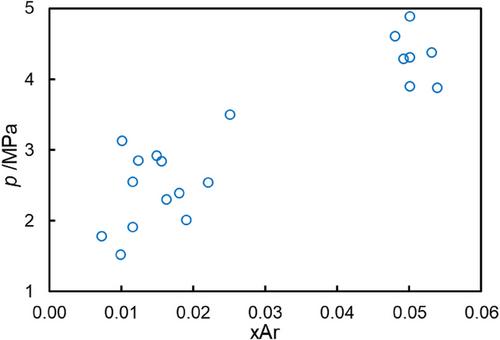下载PDF
{"title":"Effects of non-condensable CCUS impurities (CH4, O2, Ar and N2) on the saturation properties (bubble points) of CO2-rich binary systems at low temperatures (228.15–273.15 K)","authors":"Franklin Okoro, Antonin Chapoy, Pezhman Ahmadi, Rod Burgass","doi":"10.1002/ghg.2252","DOIUrl":null,"url":null,"abstract":"<p>The present work investigated the effects of some non-condensable impurities (i.e., N<sub>2</sub>, O<sub>2</sub>, CH<sub>4</sub>, and Ar) on the phase behaviour of CO<sub>2</sub>-rich systems at low temperature conditions (228.15–273.15 K). The study focused on bubble point measurements of CO<sub>2</sub>-rich systems using the isothermal (pressure–volume) method at different mole fractions of CO<sub>2</sub> (99.5%–95%). The obtained experimental data were used to validate multi-fluid Helmholtz energy approximation (MFHEA) and Peng–Robinson (PR) equations of state (EoSs). For all data points, the measurements’ uncertainties for temperature and pressure were 0.14 K and 0.03 MPa, respectively. While the composition uncertainty of the CO<sub>2</sub> systems was a maximum of 0.024%. The findings reveal that as the mole fractions of the impurities increased, the bubble point pressures of the binary mixtures were elevated. Among all the investigated impurities, N<sub>2</sub> has the most significant effect on the bubble point pressures of CO<sub>2</sub> binary mixture at all the isotherms and compositions. Both MFHEA and PR models agreed well with the measured equilibrium points. For all systems, the average absolute deviations of the measured experimental data against the MFHEA and PR EoSs, were found to be less than 3.4% and 2.2%, respectively. Although the MFHEA EoS overpredicted most of the data points, the overall trend agreed with the experimental data and was consistent with the data available in the literature. The findings imply that the presence of these non-condensable impurities (even as low as 0.5% mole fraction) increases the risk of two-phase flow at higher pressures in a CO<sub>2</sub>-rich system. © 2023 The Authors. <i>Greenhouse Gases: Science and Technology</i> published by Society of Chemical Industry and John Wiley & Sons Ltd.</p>","PeriodicalId":12796,"journal":{"name":"Greenhouse Gases: Science and Technology","volume":"14 1","pages":"62-94"},"PeriodicalIF":2.8000,"publicationDate":"2023-12-26","publicationTypes":"Journal Article","fieldsOfStudy":null,"isOpenAccess":false,"openAccessPdf":"https://onlinelibrary.wiley.com/doi/epdf/10.1002/ghg.2252","citationCount":"0","resultStr":null,"platform":"Semanticscholar","paperid":null,"PeriodicalName":"Greenhouse Gases: Science and Technology","FirstCategoryId":"93","ListUrlMain":"https://scijournals.onlinelibrary.wiley.com/doi/10.1002/ghg.2252","RegionNum":4,"RegionCategory":"环境科学与生态学","ArticlePicture":[],"TitleCN":null,"AbstractTextCN":null,"PMCID":null,"EPubDate":"","PubModel":"","JCR":"Q3","JCRName":"ENERGY & FUELS","Score":null,"Total":0}
引用次数: 0
引用
批量引用
Abstract
The present work investigated the effects of some non-condensable impurities (i.e., N2 , O2 , CH4 , and Ar) on the phase behaviour of CO2 -rich systems at low temperature conditions (228.15–273.15 K). The study focused on bubble point measurements of CO2 -rich systems using the isothermal (pressure–volume) method at different mole fractions of CO2 (99.5%–95%). The obtained experimental data were used to validate multi-fluid Helmholtz energy approximation (MFHEA) and Peng–Robinson (PR) equations of state (EoSs). For all data points, the measurements’ uncertainties for temperature and pressure were 0.14 K and 0.03 MPa, respectively. While the composition uncertainty of the CO2 systems was a maximum of 0.024%. The findings reveal that as the mole fractions of the impurities increased, the bubble point pressures of the binary mixtures were elevated. Among all the investigated impurities, N2 has the most significant effect on the bubble point pressures of CO2 binary mixture at all the isotherms and compositions. Both MFHEA and PR models agreed well with the measured equilibrium points. For all systems, the average absolute deviations of the measured experimental data against the MFHEA and PR EoSs, were found to be less than 3.4% and 2.2%, respectively. Although the MFHEA EoS overpredicted most of the data points, the overall trend agreed with the experimental data and was consistent with the data available in the literature. The findings imply that the presence of these non-condensable impurities (even as low as 0.5% mole fraction) increases the risk of two-phase flow at higher pressures in a CO2 -rich system. © 2023 The Authors. Greenhouse Gases: Science and Technology published by Society of Chemical Industry and John Wiley & Sons Ltd.
不可冷凝的 CCUS 杂质(CH4、O2、Ar 和 N2)对富二氧化碳二元体系在低温(228.15-273.15 K)下的饱和特性(气泡点)的影响
本研究调查了一些不凝杂质(即 N2、O2、CH4 和 Ar)在低温条件下(228.15-273.15 K)对富二氧化碳体系相行为的影响。研究重点是采用等温(压力-体积)法测量不同二氧化碳摩尔分数(99.5%-95%)下富二氧化碳体系的气泡点。获得的实验数据用于验证多流体亥姆霍兹能量近似(MFHEA)和彭-罗宾逊(PR)状态方程(EoSs)。对于所有数据点,温度和压力的测量不确定性分别为 0.14 K 和 0.03 MPa。二氧化碳系统的成分不确定性最大为 0.024%。研究结果表明,随着杂质摩尔分数的增加,二元混合物的气泡点压力也随之升高。在所有研究的杂质中,N2 对二氧化碳二元混合物在所有等温线和成分下的气泡点压力影响最大。MFHEA 模型和 PR 模型都与测得的平衡点吻合。在所有系统中,测量的实验数据与 MFHEA 和 PR EoS 的平均绝对偏差分别小于 3.4% 和 2.2%。虽然 MFHEA EoS 高估了大部分数据点,但总体趋势与实验数据一致,并与文献中的数据相吻合。研究结果表明,这些不可冷凝杂质(即使分子分数低至 0.5%)的存在会增加富二氧化碳系统在较高压力下发生两相流的风险。© 2023 作者。温室气体:由化学工业协会和 John Wiley & Sons Ltd. 出版。
本文章由计算机程序翻译,如有差异,请以英文原文为准。



 求助内容:
求助内容: 应助结果提醒方式:
应助结果提醒方式:


